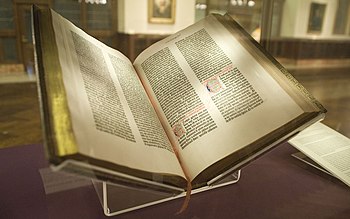Spoke 15: The Biblewheel and The 15th Century
(Go back to main Menu)
The Gutenberg Bible the Work of The Scribe
The Hebrew word used for scribe is Sopher a Samech word, the 15th letter of the Hebrew Alphabet. The Hebrew word is related to telling, recording and scribe. The 15th century is more focused on scribes, books, libraries and printing:
Though I don't think it mentions in the Bible, but the Babylonian Talmud was written while the Jews were in Babylon. And those teachings have been mentioned in certain portions in the New Testament, challenged by the Lord Jesus Christ in the Gospels, such as honoring rabbis more than parents and the forbidding of eating without washing hands in the fields.
-----
The works of scribes took momentum in the 15th century with the invention of the printing press and the fall of Constantinople when Greek scribes fled to the west, particularly to Italy:
https://en.wikipedia.org/wiki/Gutenberg_Bible
(Go back to main Menu)
The Gutenberg Bible the Work of The Scribe
The Hebrew word used for scribe is Sopher a Samech word, the 15th letter of the Hebrew Alphabet. The Hebrew word is related to telling, recording and scribe. The 15th century is more focused on scribes, books, libraries and printing:
Though I don't think it mentions in the Bible, but the Babylonian Talmud was written while the Jews were in Babylon. And those teachings have been mentioned in certain portions in the New Testament, challenged by the Lord Jesus Christ in the Gospels, such as honoring rabbis more than parents and the forbidding of eating without washing hands in the fields.
-----
The works of scribes took momentum in the 15th century with the invention of the printing press and the fall of Constantinople when Greek scribes fled to the west, particularly to Italy:
Gutenberg Bible
The Gutenberg Bible (also known as the 42-line Bible, the Mazarin Bible or the B42) was the first major book printed using mass-produced movable metal type in Europe. It marked the start of the "Gutenberg Revolution" and the age of the printed book in the West. Widely praised for its high aesthetic and artistic qualities,[1] the book has an iconic status. Written in Latin, the Gutenberg Bible is an edition of the Vulgate, printed by Johannes Gutenberg, in Mainz, in present-day Germany, in the 1450s. Since its publication, 49 copies (or substantial portions of copies) have survived, and they are considered to be among the most valuable books in the world even though no complete copy has been sold since 1978.[2][3]
In March 1455, the future Pope Pius II wrote that he had seen pages from the Gutenberg Bible, being displayed to promote the edition, in Frankfurt. It is not known how many copies were printed, with the 1455 letter citing sources for both 158 and 180 copies.
The 36-line Bible, believed to be the second printed version of the Bible, is also sometimes referred to as a Gutenberg Bible, but is possibly the work of another printer.
https://en.wikipedia.org/wiki/Gutenberg_Bible
![Biblewheel: A wise king scattereth the wicked, and bringeth the wheel over them. [Pro 20:26 KJV]](https://blogger.googleusercontent.com/img/b/R29vZ2xl/AVvXsEgiFT6-YCyrSoMjVlsXjQIWJVHaMXsChgqmAIk9mLeNmsgqWXD94k5TOPejvnORdnQ39OL3U4FleKWbC1r46q2t5nYnipb_qDZFNHQR_YXesnm6ucYt2g1DjbBhXnZmML3IHhunsYSeRBU/s1600-r/biblewheel_traced_edited.png)

No comments:
Post a Comment